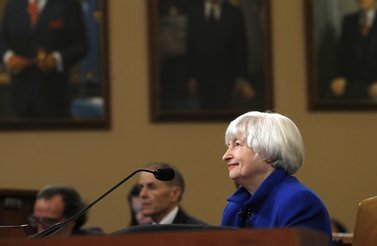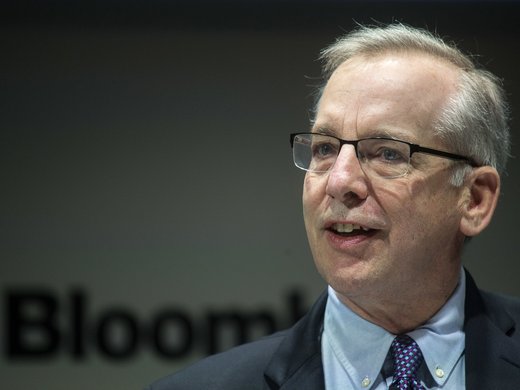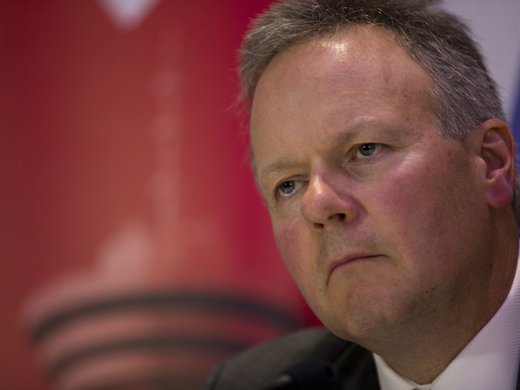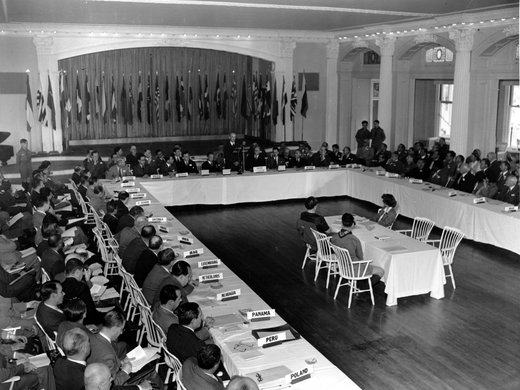Alan Greenspan initiated two big experiments as chair of the United States Federal Reserve; one made his reputation, the other ruined it.
These days, Greenspan, who ran the Fed from mid-1987 to early 2006, is remembered for how his policies contributed to the 2008 financial crisis. He deprioritized regulation, believing that no rational executive would tempt an existential crisis by taking on more risk than their firm could handle.
“Yes, I’ve found a flaw,” Greenspan told a congressional committee in October 2008, when asked if he felt his ideology had caused him to make mistakes. “I don’t know how significant or permanent it is. But I’ve been very distressed by that fact.”
Greenspan’s intuition wasn’t always faulty.
In 1996, he resolved to explain the disconnect between weak productivity data in the United States and other, anecdotal evidence that suggested advances in software and supply-chain management were making companies dramatically more efficient. Government statisticians were capturing none of that in their productivity surveys. What they were finding was lots of evidence of a hot economy; GDP grew at an annual rate of 7.2 percent in the second quarter, and the unemployment rate was low.
Seeing no evidence of productivity gains, which would allow the economy to grow faster without stoking inflation, many Fed officials were set to raise interest rates, lest prices spiral out of control. But something was telling Greenspan that could be a mistake. According to Sebastian Mallaby’s biography of the former Fed chairman, he had his staff produce a database of productivity numbers going back to 1960 for 155 separate categories of firms. Greenspan discovered that the numbers showed that productivity at services firms had declined over time — implausible, given the heavy investment in computers and software.
Greenspan took his findings to the Fed’s policy committee and made the case that the low productivity readings were the result of flawed data. His colleagues bought the argument and decided to leave interest rates unchanged, confident that increasingly efficient companies could manage a hotter economy without putting upward pressure on prices.
“I don’t think most other people who could have been Fed chairman would have seen it,” Lawrence Summers, deputy secretary of the US Treasury in the mid-1990s, told Mallaby. “I think we probably got lower unemployment for several [more] years than we would have gotten if he had not had the perception.”
All of this matters because an understanding of Greenspan could light a path out of the current low-interest-rate, high-debt predicament facing central banks in most of the world’s biggest economies.
On November 14, Bank of Canada Governor Stephen Poloz presented a paper at a conference hosted by the Federal Reserve Bank of San Francisco. In his presentation, he wondered if economies such as Canada’s were experiencing a stealth productivity boom such as the one Greenspan detected a generation ago.
Poloz told his audience that he thinks the rapid deployment of artificial intelligence (AI) could explain why inflation and interest rates are low, even though employment rates in the United States, Europe, Canada and elsewhere are unusually high.
He also noted that forecasters have consistently overestimated inflation in recent years, just as they did in the 1990s. The consistent misses have caused economists to speculate about what’s going on: the relationship between the unemployment rate and prices could be broken; globalization could be exerting extreme downward pressure on inflation; central banks’ inflation targets could have become self-fulfilling prophecies. Or could it be that interest rates are low because there are too few compelling investment opportunities to compel an aging population to invest in anything other than bonds, thereby compressing yields?
An understanding of Greenspan could light a path out of the current low-interest-rate, high-debt predicament facing central banks in most of the world’s biggest economies
“After considerable research, not much of a consensus has emerged on these questions, although there is some empirical support for all of them,” Poloz writes. But, given accumulating evidence of the effects of AI on the economy, he suggests focusing more on a different question: “Could it be that a profound positive technology shock is supporting economic growth, holding back wage growth and inflation, and redistributing resources from the goods sector to the service sector?”
Productivity matters for central bankers because it helps them estimate how much growth an economy can handle before supply constraints trigger inflation. Earlier this year, the Bank of Canada cut its estimate of potential growth in 2020 to 1.7 percent from 1.8 percent because of lower-than-expected business investment. All things equal, the revision means that Canadian policy makers now have less tolerance for economic growth, because a rate that approaches two percent could ignite inflation, which the central bank is required by law to contain.
The governor’s research suggests the central bank could be willing to apply extra judgment to the numbers produced by standard calculations.
Poloz produced evidence that it took forecasters about five years to realize what was happening with productivity in the 1990s. Statistical methods take time to adjust to new realities, and aggregate measures tend to mask the churn that is taking place below the surface when new technologies displace old ones. The creators of the disruptive technology — the first steam engines, electricity, mass production, computer chips, machine learning — do incredibly well, as do early adopters of the innovation. Others get left behind, and their struggles exert a negative force on wages and inflation. Under those circumstances, the response of central banks should be to resist overreacting, as lower interest rates could help stranded workers transition to the new economy.
“The prescription for monetary policy over the longer term is likely to be very much like that of the Greenspan era,” Poloz writes. “While inflation remains subdued, we should allow growth to run, for this is a good way of providing upside potential to those negatively affected by new technology.”
There’s a caveat.
Greenspan’s biographer, Mallaby, says his subject’s productivity call in 1996 was “brilliantly correct,” but that the monetary policy that followed might not have been. An extended period of low interest rates caused households and banks to take on excessive amounts of debt, making the financial system unstable.
The dot-com boom created more supply than demand, therefore keeping inflation at bay. But relatively cheap credit also fuelled a stock market bubble that eventually burst. Greenspan cut interest rates to clean up the mess, creating the national housing price bubble that burst not long after Greenspan retired, setting in motion the events that led to the Great Recession.
Poloz has absorbed all of this into his thinking.
He describes the current moment as the “fourth industrial revolution,” borrowing the term coined by Klaus Schwab, the head of the World Economic Forum. The first (steam power) and the second (electrification, assembly-line production) industrial revolutions also featured asset price bubbles, subsequent busts and global depressions. The third (information technology, global supply chains) also had those characteristics, although authorities managed to limit the fallout from the bust to a bad recession, rather than a full depression.
Poloz reckons policy makers and academics have learned from previous mistakes. Financial regulation has improved dramatically over the past decade, and central banks are now acutely aware that they must take not just inflation but also financial stability into account when setting interest rates. That means it’s safer to run an economy hot today than it was in 1996.
In the case of Canada, Poloz’s thinking suggests the correct policy would be an extended period of interest rates at or around the current setting.
At its latest policy meeting, the Bank of Canada expressed concern about the economic outlook, as the trade wars and lacklustre business investment forced it to lower its growth forecast. But the central bank opted against cutting interest rates because household debt levels were too high.
Poloz’s paper includes simulations of what could happen if Canada’s economy were to experience a productivity boom such as the United States experienced in the mid-1990s. According to the bank’s model, economic growth and hours worked increased significantly, but inflation slowed so much that lower interest rates would be needed to offset the divergence from target. That’s where judgment comes in.
“Financial vulnerabilities were building during the early 2000s in the US economy and elsewhere as a result of the prolonged period of low and steady interest rates, along with lax regulatory oversight, sowing the seeds of the global financial crisis,” Poloz writes. “Cutting interest rates even further in the face of the technology shock … likely would have caused those vulnerabilities to grow even more.”





